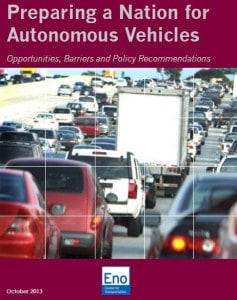 A study from the Eno Center for Transportation reports the many benefits of autonomous, self-driven, robotic driverless cars.
A study from the Eno Center for Transportation reports the many benefits of autonomous, self-driven, robotic driverless cars.
Findings in the study include:
- Autonomous vehicles have the potential to dramatically reduce crashes because driver error
is believed to be the main reason behind over 90 percent of crashes. - In central business districts, every new autonomously-driving vehicle replacing a driven car would result in approximate cost savings of $250 per year. Those cost savings result from a combination of lower land, construction, maintenance and operational costs.
- Cooperative adaptive cruise control (CACC) deployed at 10 percent, 50 percent, and 90 percent market-penetration levels will increase lanes’ effective capacities by around 1 percent, 21 percent and 80 percent, respectively.
- If 10 percent of all vehicles on a given freeway segment are AVs, there will likely be an AV in every lane at regular spacing during congested times, which could smooth traffic for all travelers.
- Emissions have been estimated to fall when travel is smooth, a 20% reduction in accelerations and decelerations should lead to 5 percent reductions in fuel consumption and associated emissions. emissions per mile could be reduced.
The study estimated that if 10% of vehicles where autonomous it could account for 1,100 lives saved, 211,000 fewer crashes, save $5.5 billion, with an economic cost savings of $430 per vehicle and comprehensive cost saving of $1,390 per AV. Parking savings equate to $3.2million and $250 per car.
v